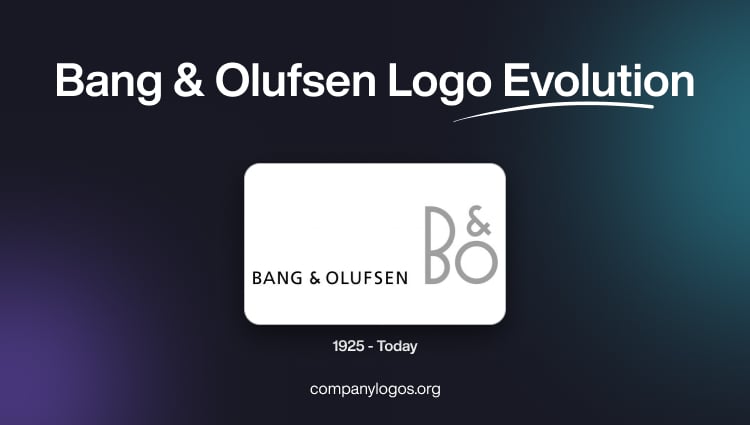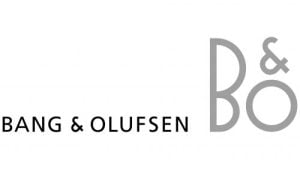
Bang & Olufsen, often abbreviated as B&O, is a Danish luxury electronics company known for its high-end audio products, televisions, and speakers that combine cutting-edge technology with timeless design. The brand was founded in 1925 by two engineers, Peter Bang and Svend Olufsen, in Struer, Denmark. Unlike conventional electronics manufacturers, Bang & Olufsen has always emphasised the fusion of performance and artistry.
It produced products that deliver exceptional sound quality and serve as design icons. The logo of B&O was introduced at the time of its founding and has not changed since. It encapsulates the journey made by the brand over the years and has become a strong visual identity for the brand that is recognised the world over. The article delves into the evolution of the B&O logo, among other details of the company.
The Genesis of the Bang & Olufsen Logo (1925 – Today)
The Bang & Olufsen logo is a combination of a neat wordmark and a graphical symbol. The wordmark “BANG & OLUFSEN” is written in black uppercase using a stylish, clean, and modern sans-serif typeface similar to Neue Frutiger Arabic Medium or Rolphie 05 Bold SC. The stylish “&” sign between the two words conveys a link between modern design and classic values.
To the right of the wordmark is the “B&O” monogram in a light grey colour. Also, the “&” sign merges both letters into a singular motif, which looks both elegant and simple. The “&” sign in the monogram looks like a stylised crown and adds a sense of prestige to the logo. Also, the upper semicircle of the letter “B” is drawn a little bigger than the lower one. Interestingly, the timeless logo was designed by a sixteen-year-old painter, Hanning Dahl Mikkelson, for just 5 kroner.

The Elements of the Bang & Olufsen Logo
Font
The uppercase wordmark in the Bang & Olufsen logo is executed using a stylish sans-serif typeface, which is similar to Neue Frutiger Arabic Medium or Rolphie 05 Bold SC.
Colour
The colour palette of the Bang & Olufsen logo consists of a combination of black and grey against a white background. The colour palette represents excellence and taking a professional approach to business.
The History of Bang & Olufsen
Bang & Olufsen (B&O) was founded in 1925 in Struer, Denmark, by engineers Peter Bang and Svend Olufsen. It was their passion for radio technology that led to the creation of their first breakthrough product, the Eliminator, which allowed radios to run directly from mains electricity instead of batteries. This innovation immediately made the company known for combining engineering excellence with elegant design. By the 1930s, B&O had expanded into producing radios and loudspeakers and had steadily built a name for quality and aesthetics.
The company faced significant challenges during the Second World War when its factory was destroyed in 1945 as part of Nazi retaliation. Undeterred, Bang & Olufsen rebuilt their business after the war. It restarted producing radios, gramophones, and early televisions that reflected both technical skill and an emerging focus on modernist design.
The 1960s and 1970s marked a defining era when B&O collaborated with visionary designer Jacob Jensen. Consequently, it introduced products such as the Beogram 4000 turntable and Beovision 3000 television. These redefined consumer electronics by making them visually striking as well as functional. This philosophy established B&O as a pioneer in integrating technology with Scandinavian design.
During the 1980s and 1990s, the company expanded internationally and positioned itself as a luxury electronics brand. It created iconic products like the sculptural Beolab loudspeakers, the Beosystem 2500 with its touch-sensitive sliding glass doors, and the ergonomically advanced Beocom telephones. These innovations ensured B&O is known for minimalism, exclusivity, and craftsmanship.
However, the early 2000s brought new challenges as digital technologies and cheaper competitors disrupted the market. To adapt, B&O launched new ventures such as B&O Play in 2012, which was a sub-brand aimed at younger consumers with portable speakers and headphones.
At the same time, it expanded into automotive audio through partnerships with premium carmakers like Audi, BMW, and Aston Martin. Although financial struggles tested the company, its design heritage and sound expertise kept it relevant.
In the modern era, Bang & Olufsen has embraced smart home integration, streaming technologies, and sustainable materials while maintaining its timeless design ethos. The products produced by the company, such as the Beosound Balance and Beovision Harmony, reflect its ability to blend tradition with innovation.
These offer high-fidelity sound and advanced engineering as well as objects of beauty. B&O is an enduring icon of Danish design and craftsmanship and is celebrated for transforming everyday electronics into works of art that embody elegance, simplicity, and emotional connection.
Interesting Facts About Bang & Olufsen
- Bang & Olufsen is a Danish luxury brand known for its distinctive approach to design and sound innovation. Since its founding in 1925, the company has combined cutting-edge technology with minimalist aesthetics. This made its products both iconic and influential within the world of audio and visual equipment.
- The company was started by Peter Bang and Svend Olufsen in a Danish farmhouse attic. Their breakthrough came with “The Eliminator”, the first mass-produced radio that could be plugged directly into a wall. This eliminated the need for batteries, which was a major leap for radios at the time.
- Bang & Olufsen has consistently blended form and function while making electronics that double as pieces of art or furniture. Their design philosophy was influenced by Bauhaus Functionalism that emphasised performance and a harmonious integration into living spaces. The brand’s hallmarks are minimalism, Scandinavian elegance, and the use of premium materials like aluminium and wood.
- Despite major setbacks, including the destruction of their factory by saboteurs during the Second World War, Bang & Olufsen rebuilt and innovated. They produced electric razors, high-quality radios, and tape recorders and expanded into television and speaker systems.
- The Beolit 39, released in 1939, was the first radio made by B&O from Bakelite plastic and introduced the now-iconic “Beo” prefix. It became especially popular with young people of its era.
- Their Beogram 4000 turntable, which was designed by Jacob Jensen, was produced using tangential tone-arm technology and received recognition from the Museum of Modern Art (MoMA).
- The Beomaster 1900 revolutionised the industry with touch-sensitive controls and is also part of the MoMA collection.
- The company’s products have often been celebrated as technological and design landmarks. In fact, there is a dedicated museum in Struer, Denmark, to showcase over 3,000 B&O creations. Throughout its history, Bang & Olufsen has left an indelible mark on both the electronics and design industries. It has influenced trends in aesthetics and user experience globally.
- Today, Bang & Olufsen continues to produce high-end audio equipment, including luxury speakers, wireless headphones, and car audio systems for brands like Aston Martin, Bentley, and Lamborghini. The company’s ongoing commitment to both sound quality and design innovation ensures its status as a benchmark in premium electronics.
- B&O was one of the first companies to develop universal remote controls and touch-sensitive electronic devices for the home.
- A large percentage of Struer’s population is involved with the company or its legacy, which highlights the importance of B&O to the local community.
- The brand’s enduring philosophy is summed up in its original vision: “A never-failing will to create only the best … persistently to find new ways.”
Finally
The Bang & Olufsen logo has not changed since its inception and reflects the brand’s journey from a small Danish electronics workshop to an internationally recognised symbol of luxury, craftsmanship, and innovation. The logo represents a brand and stands as a mark of prestige. It embodies the balance of heritage and forward-thinking design that continues to define Bang & Olufsen.